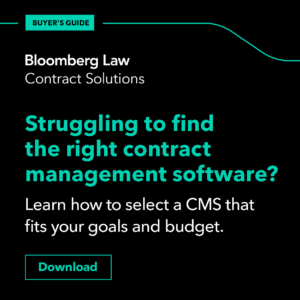
Keeping tabs on your overall contract risk profile is useful in a number of ways. It can help your internal assurance team identify operational gaps that may need to be closed. Trending data can inform your decisions about when to increase your insurance coverage, or add new types of coverage. Reviewing your contract risk data for particularly difficult quarters can help you identify times when you need to put more pressure on the sales team to stay within the standard guardrails.
How to Assess Contract Risk Using Scorecards
You don’t need expensive software to quantify your contract risk. It takes a bit more work, but it is well worth it. Even using a low-tech tool like Excel gives you the ability to capture, track, and report on the data. If your company has a business intelligence tool and you have access to a resource to help you use it, you can even create contract risk dashboards without buying a special solution.
Below is a simple example of an Excel-based contract risk scorecard, which would typically be completed by the person who drafted and negotiated the agreement.
Example Contract Risk Scorecard
Using the scorecards, you can pull the individual scores into a consolidated worksheet and report on your risk profile over time, by product, by deal size, or other metrics that are important to your leadership team. As a legal team, you will likely want to track which provisions are being changed most often, so that you can market-adjust your contract templates if needed.
Tips for Making it Work
1. Make it a habit.
Each time any member of your contracts team finalizes an agreement, make it part of your contract processing workflow to complete the scorecard, ideally the same day the deal is signed. A manual system will only work if it’s part of your team’s DNA.
2. Keep it short.
Only rank the most important provisions to your company; those that actually move the risk needle. If you start ranking more than 5-10 factors, the process will become cumbersome and you’re likely to abandon it.
3. Keep it simple.
Your risk score shouldn’t have more than 3 or 4 levels. I am partial to 4, because this eliminates the temptation to default to the middle option. Similarly, your risk weighting is unlikely to need to consist of more levels than “high,” “medium,” and “low.” As shown above, you can include some freeform fields for the team to enter additional contract terms that they feel add risk.
4. Tailor your overall rankings.
If you do more than a handful of contracts in each reporting period, you may want to assign an overall classification to a range of total scores, and use that data in your reporting. In the example above, the possible scores range from 0 to 63. Depending on your tolerance, scores from 0-15 may be considered low, 16-30 medium, and over 30 high. For some companies, however, any score higher than 0 may be considered medium risk. Other companies may want a “red flag” category for extraordinarily high risk contracts.
5. Act on the data, and celebrate wins.
Scoring isn’t done for its own sake. If you’re able to use your risk data to lower your insurance premiums, brag about it! If your judicious negotiation of payment terms helped the company reduce days sales outstanding (DSOs), make sure your team gets credit for it. If a team member uses your company’s aggregate data to convince a customer to move off of a difficult position, celebrate them. It will help you prove your team’s value, and they will be encouraged to keep up the discipline of completing those scorecards.
* * *
If you have wanted to start a practice of assessing and monitoring your company’s contract risk profile, you don’t need to wait until you get budget approval for a special solution. A few basic Excel skills and some discipline will get you well on your way.


















